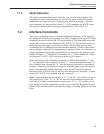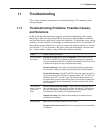
3. Set the set-point to 100°C and allow adequate time for the block to reach
this temperature and stabilize. Adjust the ALPHA calibration parameter
(see Section 6.14.3) to make the block temperature as measured with the
standard thermometer match the set-point. The approximate ratio be
-
tween a change in ALPHA and a change in temperature at 100°C is
about 0.00004 to 1. For example, if the block temperature is high by
0.1°C at 100°C, decrease ALPHA by 0.000004.
4. Set the set-point to 140°C and allow adequate time for the block to reach
this temperature and stabilize. Adjust the DELTA calibration parameter
(see Section 6.14.4) to make the block temperature as measured with the
standard thermometer match the set-point. The approximate ratio be
-
tween a change in DELTA and a change in temperature at 140°C is about
-1.7 to 1. For example, if the block temperature is high by 0.1°C at
140°C, increase DELTA by 0.17.
5. Set the set-point to –25°C and allow adequate time for the block to reach
this temperature and stabilize. Adjust the BETA calibration parameter
(see Section 6.14.5) to make the block temperature as measured with the
standard thermometer match the set-point. The approximate ratio be-
tween a change in BETA and a change in temperature at –25°C is about
-50 to 1. For example, if the block temperature is high by 0.1°C at
–25°C, increase BETA by 5.0.
6. Repeat Step 1 to ensure the instrument is now accurate throughout the
full range.
9011 Dual-Well Calibrator
User’s Guide
46


















